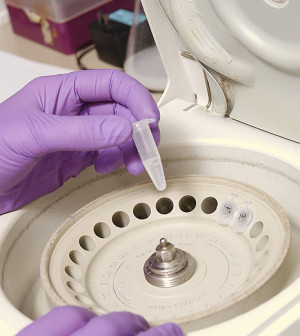- Skip Storing This Everyday Product in the Fridge Door
- Green Tea + B3 Pairing May Boost Brain Health
- Navigating Your Midlife Crisis: Embracing New Possibilities
- City Raccoons Showing Signs of Domestication
- Mapping the Exposome: Science Broadens Focus to Environmental Disease Triggers
- One Week Less on Social Media Linked to Better Mental Health
- Your Brain Changes in Stages as You Age, Study Finds
- Some Suicide Victims Show No Typical Warning Signs, Study Finds
- ByHeart Formula Faces Lawsuits After Babies Sickened With Botulism
- Switch to Vegan Diet Could Cut Your Greenhouse Gas Emissions in Half
Cystic Fibrosis Drug Combo May Be Less Effective Than Hoped


A powerful drug combo may not be as effective against cystic fibrosis as previously thought. New lab research on human cells suggests that one of the medications might stop the other from working properly.
However, this study’s findings aren’t definitive, and there’s still hope for the medications known as ivacaftor (brand name Kalydeco) and lumacaftor, according to the study’s senior author.
“The development of drugs like ivacaftor and lumacaftor is undoubtedly a step forward, but our study suggests that more work will need to be done before we can realize the full potential of these drugs,” said Martina Gentzsch, an assistant professor with the department of cell biology and physiology at the University of North Carolina, Chapel Hill.
“Fortunately, we now have a better understanding of some of the potential pitfalls to these drug combinations and a means to test alternative strategies to make these drugs more effective,” said Gentzsch.
Alan Smyth, a professor of child health and division head at the University of Nottingham in England, cautioned that initial research in people, not on cells in the laboratory as was done here, was more promising. The drug combo seems to work, he said, and newer drugs of a similar type may help scientists improve on their performance.
Cystic fibrosis affects an estimated 30,000 people in the United States, according to the Cystic Fibrosis Foundation. It’s an inherited disease that disrupts cells in the lungs and the pancreas, causing mucus to become thick and sticky. The mucus builds up, causing breathing and digestion problems.
“Existing medications target only the symptoms of cystic fibrosis but not the cause of the disease,” Gentzsch said. “As a result, they may lead to improvement but do not prevent the overall slow progression of lung disease over time. In addition, many current therapies are time-consuming and can be more difficult to use in young children.”
A newer drug known by the brand name Kalydeco targets a protein that doesn’t work properly in certain people with cystic fibrosis. Researchers have praised the medication, but it only works in an estimated 5 percent of patients who have a specific genetic variation.
The big question is whether Kalydeco and a drug that’s in development known as lumacaftor might provide a one-two punch to treat the wide majority of cystic fibrosis patients. If the combo worked, as some short-term studies have suggested, “the hope would be that disease progression would be slowed and that patients would live longer, healthier lives,” Gentzsch said.
But the new study raises doubts. The researchers tested the drugs on epithelial cells, which are found in much of the body, and found evidence that Kalydeco actually reverses some of the effects of lumacaftor. “This is consistent with results reported from recent clinical trials that showed meaningful but modest improvements in lung function in patients treated with this drug combination,” Gentzsch said.
Scientists believe Kalydeco helps water escape cells so it can moisten mucus, while lumacaftor paves the way for liquid to get where it’s supposed to go. But the study suggests Kalydeco disables some of lumacaftor’s effects.
Gentzsch said other medications and other combinations of treatments could indeed benefit patients. Future research into how they affect specific types of patients could lead to more insight into whether they’re worthwhile treatments, she said.
The study appears in the July 23 issue of Science Translational Medicine. It was funded by the U.S. National Institutes of Health, the Cystic Fibrosis Foundation, and the Else Kroner-Fresenius Foundation.
More information
For more details about cystic fibrosis, visit the Cystic Fibrosis Foundation.
Source: HealthDay
Copyright © 2025 HealthDay. All rights reserved.










